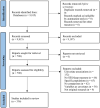Socioeconomic status and sleep health: a narrative synthesis of 3 decades of empirical research
- PMID: 36239056
- PMCID: PMC9978435
- DOI: 10.5664/jcsm.10336
Socioeconomic status and sleep health: a narrative synthesis of 3 decades of empirical research
Abstract
Study objectives: This review aims to assess the association between socioeconomic status (SES) and sleep health in the general population and the mediating effects of lifestyle and mental and physical health in this relationship.
Methods: Observational studies testing the independent association between objective or subjective SES indicators and behavioral/physiological or clinical sleep health variables in the general population were included. PubMed/MEDLINE was searched for reports published from January 1990 to December 2019. The direction of effect was used as the primary effect measure, testing the hypothesis that low SES is associated with poor sleep health outcomes. Results are presented in the form of direction effect plots and synthesized as binomial proportions.
Results: Overall, 336 studies were identified. A high proportion of effects at the expected direction was noted for measures of sleep continuity (100% for sleep latency, 50-100% for awakenings, 66.7-100% for sleep efficiency), symptoms of disturbed sleep (75-94.1% for insomnia, 66.7-100% for sleep-disordered breathing, 60-100% for hypersomnia), and general sleep satisfaction (62.5-100%), while the effect on sleep duration was inconsistent and depended on the specific SES variable (92.3% for subjective SES, 31.7% for employment status). Lifestyle habits, chronic illnesses, and psychological factors were identified as key mediators of the SES-sleep relationship.
Conclusions: Unhealthy behaviors, increased stress levels, and limited access to health care in low-SES individuals may explain the SES-sleep health gradient. However, the cross-sectional design of most studies and the high heterogeneity in employed measures of SES and sleep limit the quality of evidence. Further research is warranted due to important implications for health issues and policy changes.
Citation: Papadopoulos D, Etindele Sosso FA. Socioeconomic status and sleep health: a narrative synthesis of 3 decades of empirical research. J Clin Sleep Med. 2023;19(3):605-620.
Keywords: education; employment status; income; insomnia; sleep duration; sleep health; sleep quality; socioeconomic status.
© 2023 American Academy of Sleep Medicine.
Conflict of interest statement
All authors have seen and approved the manuscript. Work for this study was performed at the Army Share Fund Hospital, Greece and the Redavi Institute, Canada. The authors report no conflicts of interest.
Figures



Similar articles
-
Socioeconomic status and sleep duration among a representative, cross-sectional sample of US adults.BMC Public Health. 2024 Dec 18;24(1):3410. doi: 10.1186/s12889-024-20977-w. BMC Public Health. 2024. PMID: 39695529 Free PMC article.
-
Association of socioeconomic status with sleep disturbances in the Swiss population-based CoLaus study.Sleep Med. 2015 Apr;16(4):469-76. doi: 10.1016/j.sleep.2014.12.014. Epub 2015 Feb 7. Sleep Med. 2015. PMID: 25777484
-
Socioeconomic disparities in obstructive sleep apnea: a systematic review of empirical research.Sleep Breath. 2021 Dec;25(4):1729-1739. doi: 10.1007/s11325-020-02274-z. Epub 2021 Jan 16. Sleep Breath. 2021. PMID: 33452999
-
Sleep Habits and Susceptibility to Upper Respiratory Illness: the Moderating Role of Subjective Socioeconomic Status.Ann Behav Med. 2017 Feb;51(1):137-146. doi: 10.1007/s12160-016-9835-3. Ann Behav Med. 2017. PMID: 27679462 Free PMC article.
-
Socioeconomic status and sleep disturbances among pediatric population: a continental systematic review of empirical research.Sleep Sci. 2021 Jul-Sep;14(3):245-256. doi: 10.5935/1984-0063.20200082. Sleep Sci. 2021. PMID: 35186203 Free PMC article. Review.
Cited by
-
Assessment of Sleep Quality and Its Determinants Among Patients with Type 2 Diabetes Mellitus in Mogadishu, Somalia: A Cross-Sectional Study.Diabetes Metab Syndr Obes. 2025 Jun 15;18:1949-1965. doi: 10.2147/DMSO.S533810. eCollection 2025. Diabetes Metab Syndr Obes. 2025. PMID: 40538564 Free PMC article.
-
The mediating role of subjective social status in the association between objective socioeconomic status and mental health status: evidence from Iranian national data.Front Psychiatry. 2024 Sep 30;15:1427993. doi: 10.3389/fpsyt.2024.1427993. eCollection 2024. Front Psychiatry. 2024. PMID: 39403319 Free PMC article.
-
Social class discrimination during adolescence as a mediator of socioeconomic disparities in actigraphy-assessed and self-reported sleep.Sleep Med. 2023 Aug;108:61-70. doi: 10.1016/j.sleep.2023.05.021. Epub 2023 Jun 1. Sleep Med. 2023. PMID: 37331131 Free PMC article.
-
Perceptions of sleep and sleep research among African American adults.Sleep Health. 2025 Jul 1:S2352-7218(25)00115-9. doi: 10.1016/j.sleh.2025.05.007. Online ahead of print. Sleep Health. 2025. PMID: 40603172
-
The Relationship Between Socioeconomic Status and Health Behaviors in Older Adults: A Narrative Review.Healthcare (Basel). 2025 Jul 10;13(14):1669. doi: 10.3390/healthcare13141669. Healthcare (Basel). 2025. PMID: 40724694 Free PMC article. Review.
References
-
- Tobaldini E , Costantino G , Solbiati M , et al. . Sleep, sleep deprivation, autonomic nervous system and cardiovascular diseases . Neurosci Biobehav Rev. 2017. ; 74 ( Pt B ): 321 – 329 . - PubMed
-
- Itani O , Jike M , Watanabe N , Kaneita Y . Short sleep duration and health outcomes: a systematic review, meta-analysis, and meta-regression . Sleep Med. 2017. ; 32 : 246 – 256 . - PubMed
-
- Papadopoulos D , Sosso FAE , Khoury T , Surani SR . Sleep disturbances are mediators between socioeconomic status and health: a scoping review . Int J Ment Health Addict. 2020. ; 20 ( 1 ): 480 – 504 .
Publication types
MeSH terms
LinkOut - more resources
Full Text Sources
Medical

